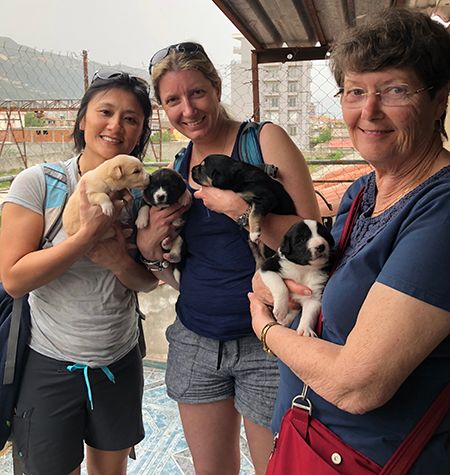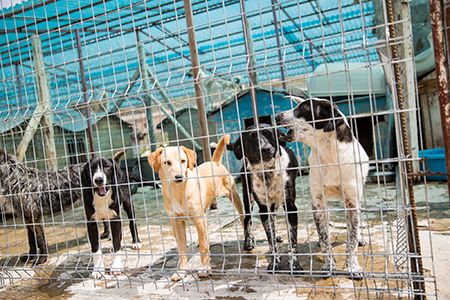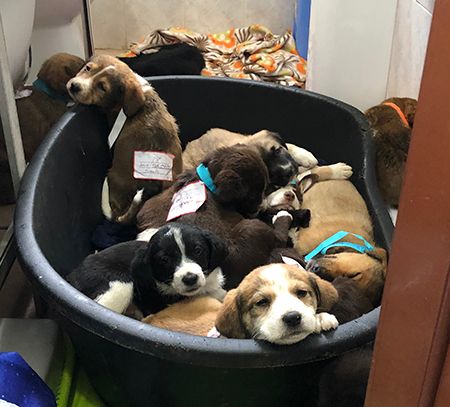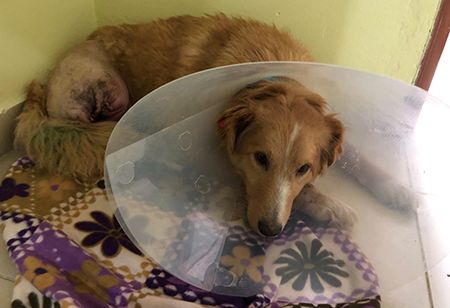My well-being fix: A trip overseas with World Vets
People ask me why I pay to volunteer to provide veterinary services thousands of miles from home. My simple answer? Because it makes me feel good.

Sometimes being a veterinarian does mean you do get to play with puppies, like these 2-week-old cuties at the Protect Me Albania animal shelter, who are being cuddled by Dr. Jade Huynh, Dr. Colleen Mullally and Valerie Mullally. (All photos courtesy of Dr. Mullally.)On a daily basis at work I hear someone say sarcastically that they're “living the dream.” I know I'm guilty of saying it too. As an emergency and critical care veterinarian in a high-volume specialty practice, I find that it's easy to lose sight of why I became a veterinarian. In fact, I know that most of us-whether we're in general practice, specialty, small animal, equine, large animal, or zoo and exotics practice-have days we question why we became veterinarians. Our lives could be so much easier with less stress … right?
The reality for me is that I am living my dream. I've wanted to be a vet since I was 8 years old, and while I joke around some days about moving to an island and becoming a SCUBA instructor, I really don't know what career path I would have chosen had I not gone to veterinary school.
So this is my dream, even if some days I want to yell back at a client, euthanize a pet I feel owners have gone too far with or just curl up under the covers cuddling my own furry family members and cry because I couldn't save a patient. I'm guilty of becoming disillusioned, frustrated, depressed and angry, but I've found the best way to remember why I chose veterinary medicine is to travel to other countries where there is no veterinary care and give of my time and skills.
World Vets was founded in 2006 by Cathy King, DVM, PhD, when she realized a need for veterinary care in underdeveloped countries. At its core is the belief that all animals deserve kindness and compassion. Since its inception, World Vets has grown to include veterinary field service programs, disaster relief, training and civil-military humanitarian aid. The organization has worked in 46 countries on six continents and has more than 4,000 volunteers.
I was lucky enough to go on my first World Vets trip to Roatan, Honduras, in 2008 with two of my close friends from vet school, and since then I've been hooked, although a busy emergency and critical care life has prevented me from going on trips as often as I'd like. My second trip was to Ibarra, Ecuador, in 2012, and the third trip was to the Dominican Republic in 2017, when I convinced my mom (a retired RN) to come with me as a volunteer. Although the trips cost money (roughly $1,250 for hotel, gound transportation, supplies and some meals, plus the cost of flights), the experience and ability to feel like you're giving back is well worth the cost.
In April 2018 I traveled to Vlore, Albania, for my fourth World Vets trip. This was a pilot project, and none of us knew what to expect. On our second full day in the country we headed to the Protect Me Albania shelter for setup. As we entered the compound all we could hear were barking dogs and all we saw were large kennels with 10 or more dogs each that looked happy and well-fed. A two-story building backed the kennels, and this was to be our clinic for the next three days.

Happy Albanian dogs at Protect Me Albania.Liljana Breshani, the founder of Protect Me, took us inside, where we explored and went to say hi to some of our patients. That's when I met Laika, an adult female 40-ish-pound dog that clearly had an old fracture affecting her right rear leg. She had been found as a stray unable to use the leg and had spent more than a month with one of the local vets, who had “fixed the leg and put a pin in it.” The leg was clearly painful. The distal tibia and tibia-tarsal joint were unstable, and the skin had a superficial infection. What's more, a 3-month-old puppy had decided to use Laika's leg as a chew toy. After evaluating her we recommended amputation. The shelter staff was hesitant and worried that she would be in more pain, but we assured them it was the right decision.
On our first day of clinics it was decided I would be Laika's surgeon. In my everyday job working with boarded surgeons I don't do much surgery. I do occasional lacerations, bite wounds and enucleations-but not amputations. I'm more likely to put a dog on a ventilator than amputate a limb these days. Luckily, with today's technology I knew I could get quick access to Fossum's Small Animal Surgery text. I had a friend in the U.S. snap a few pics of the pages on amputation and text them to me.
I quickly reviewed the pages. Although I hadn't done an amputation in years, I knew I would have backup. My closest friend and veterinary school classmate was also on the trip and was one surgical table away, and my mom scrubbed in to help stabilize the limb. Laika was given an epidural, set up on a lidocaine-ketamine constant-rate infusion, scrubbed and prepped, induced with injectable anesthetics and intubated. Although World Vets doesn't have gas anesthesia or oxygen, I felt more comfortable knowing she had an endotracheal tube in should something happen. I quickly removed her painful leg and sent her to recovery. Then I went right back to work doing spays and neuters.

How many puppies can fit in one bathroom? These were all successfully spayed or neutered by World Vets volunteers.Laika recovered uneventfully and seemed comfortable when we left that night. Over the next two days of clinics I kept a watchful eye on her, giving her extra injectable pain medications and fluids and hand-feeding her, just like I would for my patients at home. By the end of our last day I felt confident Laika would continue to do well. Three weeks after coming home I sent a message to the shelter asking how she was doing and received reports that she was doing well-her incision had healed and they were taking her to Italy to be adopted.

Laika recovering after a successful amputation.People have asked me why I pay to volunteer to do what I do at home in my own country. My simple answer is because I can and because it makes me feel good. Something happens on a World Vets trip that can't easily be explained. All the irritation and frustrations from working with difficult clients and dealing with workplace politics disappears.
On a World Vets trip, you take the skills you learned in vet school and just get to work doing what has to be done. I'm proud of the fact that I can do an amputation, enucleation, splenectomy, spay, neuter, autotransfusion and even successful CPR in a field medicine setting without all the bells and whistles. These trips with World Vets help me remember why I became a veterinarian. You realize that you can do a good job without the equipment and staff you have at home and you can make a difference in the lives of animals and people thousands of miles from home.
You make new friends, whether they're other vets, technicians, volunteers or the ground staff in the country where you're working. You see the smiling faces of the people whose animals you're helping and know you're making a difference. You see the animals and remember that they are why you became a veterinarian.
Dr. Colleen Mullally is a staff veterinarian with VCA SouthPaws Veterinary Specialists & Emergency Center in Fairfax, Virginia. For more information about World Wets, visit worldvets.org. For more on Protect Me Albania, see protectmealbania.com.